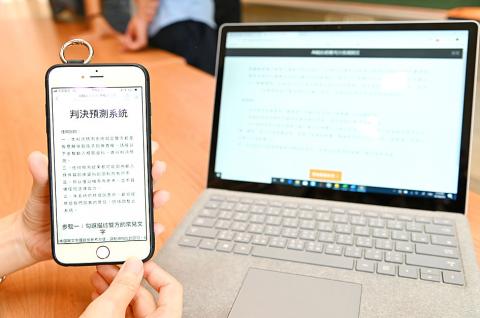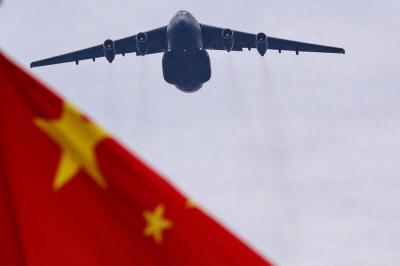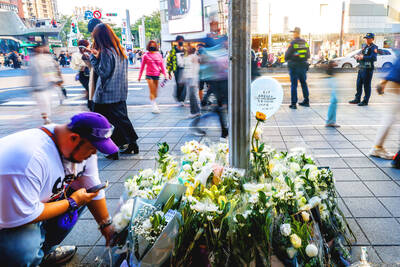National Tsing Hua University yesterday unveiled a program that uses artificial intelligence to predict the outcome of child custody cases, which the university said was more than 90 percent accurate.
The system was developed by a team headed by National Center for Theoretical Sciences physics professor Wang Daw-wei (王道維) and Lin Yun-hsien (林昀嫺), a professor in the university’s Institute for Law and Science.
The program was fed 2,000 rulings from 2015 to 2017 to serve as a database and model for judges’ decisionmaking patterns, Wang said.

Photo: Hung Mei-hsiu, Taipei Times
As custody battles are usually acrimonious and bitter, a legal resolution is not necessarily the best way, Lin said.
The program could reduce courts’ workload by allowing both parties to understand the possible results of a legal case, she said, adding that this could result in fewer court cases and waste of social resources, while increasing the number of out-of-court settlements.
A number of countries have started using AI, although it is still restricted to the analysis of potential for recividism or settling credit card disputes, Wang said.
Eventually, the program could be expanded into other legal areas, he said.
The Civil Code’s regulations on who should get custody based on the child’s best interests cite instances that are not easily defined, such as the willingness of the child to stay with the parent; the finances and vocation of the parent and how they interact with the child, Wang said.
Using the program is easy, such as ticking off certain boxes on a list or narrating the situation to the computer, Wang said.
The computer would then provide projections of the ruling, Wang said.
For example, Jane, worried that she would not obtain custody of her child if she filed for a divorce with John, who is having an extramarital affair, could tell the program that she is the primary caretaker and can provide a stable and positive life for the child while also saying that John has a stable job that could help provide for Jane and the child.
The program would provide an estimate within seconds; in this case, Jane would have a 72 percent chance of getting custody, John a 13 percent chance and joint custody a 15 percent chance, Wang said.
The program uses a technology whose patent is pending, said Lee Ya-lun (李亞倫), the team’s data science analyst, adding that it has adopted an artificial neural network to boost efficiency.
The team said it would be holding discussions with legal experts, practicing lawyers, judicial personnel and social welfare workers to obtain more data, to help them present a more rounded program with subroutines and ancillary measures that could be customized to an individual’s needs.

Beijing could eventually see a full amphibious invasion of Taiwan as the only "prudent" way to bring about unification, the US Department of Defense said in a newly released annual report to Congress. The Pentagon's "Annual Report to Congress: Military and Security Developments Involving the People's Republic of China 2025," was in many ways similar to last year’s report but reorganized the analysis of the options China has to take over Taiwan. Generally, according to the report, Chinese leaders view the People's Liberation Army's (PLA) capabilities for a Taiwan campaign as improving, but they remain uncertain about its readiness to successfully seize

Taiwan is getting a day off on Christmas for the first time in 25 years. The change comes after opposition parties passed a law earlier this year to add or restore five public holidays, including Constitution Day, which falls on today, Dec. 25. The day marks the 1947 adoption of the constitution of the Republic of China, as the government in Taipei is formally known. Back then the Chinese Nationalist Party (KMT) governed China from Nanjing. When the KMT, now an opposition party in Taiwan, passed the legislation on holidays, it said that they would help “commemorate the history of national development.” That

HORROR STORIES: One victim recounted not realizing they had been stabbed and seeing people bleeding, while another recalled breaking down in tears after fleeing A man on Friday died after he tried to fight the knife-wielding suspect who went on a stabbing spree near two of Taipei’s busiest metro stations, Taipei Mayor Chiang Wan-an (蔣萬安) said. The 57-year-old man, identified by his family name, Yu (余), encountered the suspect at Exit M7 of Taipei Main Station and immediately tried to stop him, but was fatally wounded and later died, Chiang said, calling the incident “heartbreaking.” Yu’s family would receive at least NT$5 million (US$158,584) in compensation through the Taipei Rapid Transit Corp’s (TRTC) insurance coverage, he said after convening an emergency security response meeting yesterday morning. National

Taiwan has overtaken South Korea this year in per capita income for the first time in 23 years, IMF data showed. Per capita income is a nation’s GDP divided by the total population, used to compare average wealth levels across countries. Taiwan also beat Japan this year on per capita income, after surpassing it for the first time last year, US magazine Newsweek reported yesterday. Across Asia, Taiwan ranked fourth for per capita income at US$37,827 this year due to sustained economic growth, the report said. In the top three spots were Singapore, Macau and Hong Kong, it said. South